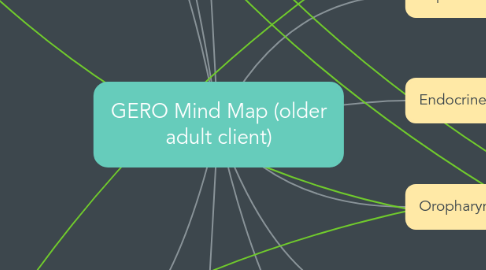
1. Immunity
1.1. Immunosenescence
1.1.1. Depressed immune response
1.1.1.1. Risk for infections
1.2. Thymine mass decreases
1.3. T cell activity declines
1.3.1. Immature T cells are present in the thymus
1.4. Inflammatory defenses decline
1.4.1. Inflammation presents atypically
1.5. Increase in pro-inflammatory cytokines
2. Neurological / Cognitive
2.1. Loss of nerve cell mass
2.1.1. Atrophy of the brain & spinal cord
2.2. Number of nerve cell declines
2.2.1. Slow nerve conduction
2.2.1.1. Response and reaction times are slower; reflexes become weaker
2.3. Slowing in central processing
2.3.1. Delays the time required to perform tasks
2.3.2. Delirium
2.3.2.1. S/S
2.3.2.1.1. Hypervigilance
2.3.2.1.2. Hallucinations
2.3.2.1.3. Personality changes
2.3.2.1.4. Altered LOC
2.3.2.2. Nursing Interventions
2.3.2.2.1. Avoid bright lights
2.3.2.2.2. Frequent orientations
2.3.3. Dementia
2.3.3.1. S/S
2.3.3.1.1. Impaired judgment
2.3.3.1.2. Inappropriate behavior
2.3.3.1.3. Difficulty w/coordinated movements
2.3.3.2. Nursing Interventions
2.3.3.2.1. Avoid restraining them
2.3.3.2.2. Create a safer environment
2.3.3.2.3. ID bracelets
2.4. Number & sensitivity of sensory receptors, dermatomes, and neurons decrease
2.4.1. Dulling of tactile sensation
2.5. Decline in the function of cranial nerves mediating taste and smell
3. Musculoskeletal
3.1. Decrease in number & size of muscle fibers
3.2. Decline in muscle mass
3.3. Grip strength endurance declines
3.3.1. Sarcopenia
3.3.1.1. Causes
3.3.1.1.1. Disease
3.3.1.1.2. Immobility
3.3.1.1.3. Decreased caloric intake
3.3.1.1.4. Poor blood flow to muscle
3.3.1.1.5. Decline in anabolic hormones
3.3.1.1.6. increase in proinflammatory cytokines
3.4. Decrease body strength
3.5. Reduce flexibility of joints & mucles
3.5.1. Osteoarthritis
3.5.1.1. S/S
3.5.1.1.1. Crepitation on joint motion
3.5.1.1.2. Distal joints may develop bony nodules
3.5.1.2. Tx
3.5.1.2.1. Isometrics & mild exercises
3.5.1.2.2. Analgesics
3.5.1.2.3. Rest, heat or ice
3.5.1.2.4. Weight reduction
4. Respiratory
4.1. Reduced coughing d/t blunting of laryngeal & coughing reflexes
4.1.1. Risk for
4.1.1.1. Lung abscess
4.1.1.1.1. S/S
4.1.1.1.2. Tx
4.1.2. Nursing Interventions
4.1.2.1. Promote productive coughing
4.1.2.1.1. Hard candy/sweets increase secretions
4.1.2.1.2. Humidifiers
4.1.2.1.3. Expectorants
4.1.2.1.4. Fluid intake
4.1.2.2. Perform postural drainage
4.1.2.2.1. Use aerosol meds BEFORE, oral care AFTER
4.1.2.2.2. Discontinue IF
4.2. Lungs smalll in size & weight
4.3. Reduced secretions
4.3.1. Chronic Bronchitis
4.3.1.1. S/S
4.3.1.1.1. productive cough
4.3.1.1.2. Wheezing
4.3.1.1.3. SOB
4.3.1.2. Tx
4.3.1.2.1. Removal of secretions
4.3.1.2.2. Prevent obstructions
4.3.1.2.3. Fluids
4.4. Hair in nostrils become thicker
4.5. Trachea stiffens d/calcification
5. Renal / GU
5.1. Hypertrophy of the bladder muscle / thickening of teh bladder
5.1.1. Decreases storage capacity
5.1.1.1. Urinary frequency
5.2. Weaker bladder muscles
5.2.1. Urinary retention
5.2.1.1. S/S
5.2.1.1.1. Urinary frequency, straining, dribbling, palpable bladder
5.2.1.2. Risk for
5.2.1.2.1. UTIs
5.3. Filtration efficiency decreases
5.3.1. Risk for
5.3.1.1. Adverse drug reactions
5.3.1.2. Increase of BUN
5.3.1.2.1. S/S
5.3.1.3. Glomerulonephritis
5.3.1.3.1. S/S
5.3.1.3.2. Tx
5.4. Decreased tubular function
5.5. Decreased concentration of urine
6. Reproductive
6.1. Male
6.1.1. Enlargement of prostate gland
6.1.1.1. Risk for
6.1.1.1.1. Benign prostatic hyperplasia
6.1.2. Atrophy of testes
6.1.3. Reduction in sperm count
6.1.4. Reduction in testicular mass
6.1.5. Increased fibrosis in the seminiferous tubules
6.2. Female
6.2.1. Vulva atrophies
6.2.2. Vaginal environment drier & more alkaline
6.2.2.1. Uncomfortable intercourse
6.2.2.2. Vaginitis
6.2.2.2.1. S/S
6.2.2.2.2. Nursing interventions
6.2.2.2.3. Tx
6.2.3. Ovaries become thicker & smaller
6.2.4. Uterus decrease in size
6.2.5. Fallopian undergo shortening & straightening
7. Endocrine
7.1. Thyroid gland atrophies
7.2. Thyroid gland activity decreases
7.2.1. Low metabolic rate
7.2.2. Hypothyroidism
7.2.2.1. S/S
7.2.2.1.1. Fatigue, weakness, lethargy
7.2.2.1.2. Anorexia
7.2.2.1.3. Weight gain
7.2.2.2. Tx
7.2.2.2.1. Synthetic T4
7.2.2.3. Nursing Interventions
7.2.2.3.1. Support tx plan
7.2.2.3.2. Assist patients w/management of symptoms
7.3. Adrenocorticotropic hormone secretion decreases w/age
7.3.1. Reduces secretory activity of adrenal gland
7.3.1.1. Reduces secretion of estrogen, progesterone
7.4. Volume of pituitary gland decreases w/age
7.5. Insufficient release of insulin
7.5.1. Diabetes Mellitus
7.5.1.1. Tx: Drug Therapy
7.5.1.1.1. Metformin
7.5.1.1.2. Sulfonylurea drugs
7.5.1.2. Nursing interventions
7.5.1.2.1. Establish a teaching plan for pt
7.5.1.2.2. Assess readiness to learn
7.5.1.2.3. Provide environment conducive to learning
8. Oropharyngeal / GI
8.1. Tongue atrophies
8.1.1. Affect taste buds
8.1.2. Decrease taste sensations
8.1.2.1. Xerostomia
8.1.2.1.1. Tx
8.1.2.1.2. Nursing Interventions
8.2. Saliva production decreases
8.2.1. Swallowing more difficult
8.2.1.1. Dysphagia
8.2.1.1.1. S/S
8.2.1.1.2. Nursing interventions
8.3. Thinning of the oral mucosa
8.3.1. Reduction in chewing efficiency
8.4. Esophageal & stomach motility decreases
8.4.1. Risk for
8.4.1.1. Indigestion
8.4.1.2. Aspiration
8.5. Decreased elasticity of the stomach
9. Integumentary
9.1. Flattening of dermal epidermal junction
9.2. Reduced thickness & vascularity of the dermis
9.2.1. Slows epidermal proliferation
9.2.2. Increased quantity & degeneration of elastin fibers occur
9.3. Collagen fibers become coarser
9.3.1. Reduce skin elasticity
9.4. Dermis becomes more avasular & thinner
9.5. Subcutaneous fat is lost
9.5.1. Lines, wrinkles, sagging
9.5.1.1. Skin breaks down easily
9.6. Loss of pigment cells & atrophy of hair bulbs
9.6.1. Hair thins & grays
9.6.2. Hair in nose & ears become thicker
10. Cardiovascular
10.1. Vasoconstriction
10.1.1. Hypertension
10.1.1.1. S/S
10.1.1.1.1. Systolic pressure >140
10.1.1.1.2. Diastolic pressure >90
10.1.1.1.3. Dull headache
10.1.1.1.4. Impaired memory
10.1.1.2. Nursing Interventions
10.1.1.2.1. Assess BP when pt is standing, sitting, prone
10.1.1.2.2. Assess pt factors contributing to BP
10.1.1.3. Tx
10.1.1.3.1. DASH diet
10.1.1.3.2. Yoga
10.1.1.3.3. Meditation
10.1.1.3.4. Thiazide diuretics
10.2. Valves become thicker
10.3. Myocardial muscle less efficient
10.3.1. Reduction in CO
10.4. Less sensitive to baroreceptor regulation of BP
10.5. Calcification & reduced elasticity of vessels
10.5.1. Varicose Veins
10.5.1.1. S/S
10.5.1.1.1. Dull pain
10.5.1.1.2. Cramping of the legs
10.5.1.1.3. Dizziness
10.5.1.2. Tx
10.5.1.2.1. Elevate limb to promote venous returne
10.5.1.2.2. Exercise to enhance circulation
10.5.1.2.3. Stockings
10.5.1.3. Nursing Interventions
10.5.1.3.1. Promoting circulation
10.5.1.3.2. Providing foot care

